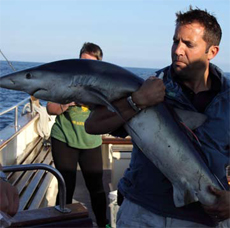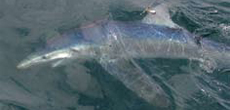




| Home | Features | Club Nights | Underwater Pics | Feedback | Non-Celebrity Diver | Events | 8 August 2025 |
| Blog | Archive | Medical FAQs | Competitions | Travel Offers | The Crew | Contact Us | MDC | LDC |

|

|
 
 |
 |
ISSUE 8 ARCHIVE - TO CATCH A SHARKJuliet SavigearOK, the idea of fishing for shark to us divers, seems to be wrong, evil and 'NO' we all scream together. It doesn't matter if the shark gets put back alive into the water. Certainly when I saw the advertising boards at the harbour of St Mary's on the Isles of Scilly, there was something that grated at the back of my mind. However, there is still much to be learnt about these beautiful fish and without this knowledge it would be nigh on impossible to help protect their rather bleak-looking future. So, what does catching and tagging the sharks in our waters hope to achieve?Local Scillonian skipper, Joe Pender, runs regular pelagic trips during the summer months from his boat, Sapphire. Mostly targeted towards the birders, these excursions out to sea will often give the punters the opportunity to see both rare and occasional visitors in or above the rich waters around the Isles of Scilly. Chumming the water will not only attract the endearing storm petrels (top this, at least nine wilson's petrels now that'll get any birder excited); skuas; shearwaters, terns and a whole host of seagulls (Sabine's if you're lucky); but will also bring in the possibility of a blue shark. Whilst I was out on the trip at the beginning of August, Joe spent half and hour bringing in a blue shark that got away just at the last minute. It was hard to watch as the shark fought against the line. The haunting, unmistakable shadow of the shark freely gliding by our boat half an hour earlier is definitely the image that will stay in my head. |
 |

|
Joe was the first skipper on the islands to begin tagging
blue shark back in 1996 and became involved in the UK
Shark Tagging Programme through a friend of his. Today
there are around a hundred regular 'taggers' in the UK.
The best time of year to catch blue shark around the islands is from mid July through to mid September when the water temperature is above 14ēC, with the month of August usually being the busiest (in early August, Joe caught seven blue shark in three trips, over eight hours of drifting). Although numbers have generally decreased over the thirteen years that Joe has been tagging the shark, 2009 has been a busy year, which Joe possibly puts down to some restrictions in commercial fishing. Sadly this is not showing in the general UK figures from the UK Shark Tagging Programme. Dr Ken Collins, who helps to run the programme from the National Oceanography Centre in Southampton, said that "restrictions concerning sharks are very weak". |
 |
|
The blue sharks that are caught and tagged by Joe Pender
are an average size of 50lb and reach up to around 130
150lb. The largest sharks can be around eight feet in length.
Once they hit this size they generally just fill out. The majority
of the blue sharks that are tagged are females as it appears
they show definite separation of sexes during their Atlantic
migration. Once tagged and released by Joe, the sharks
that have been recaptured have been found anywhere
from: south west of The Lizard; France; Portugal; Madeira and
as far as the Cape Verde Islands and The Azores. Sadly, most
of the blue sharks that are tagged in the programme are
recaptured by Spanish long-liners after tuna.
Whenever a Blue Shark is caught, its weight is recorded and a numbered tag inserted just below the dorsal fin. Upon subsequent recapture the shark will be weighed again so that growth can be recorded. The programme hopes to gain greater understanding into shark movements. If the same shark is caught by different anglers then more information will be gained of their migration patterns. It is also important to check if any female that is caught is gravid (pregnant) or not. If a non-gravid female is caught and later recaptured gravid, this would indicate that between times the shark has mated. Monitoring this information can help to indicate breeding areas, particularly if there are large numbers of 'just pupped size' sharks within an area. Gaining an insight into the breeding areas is one of the key parts of the research that Dr Ken Collins is looking for, in the hope of getting the "declaration of closed areas for known pupping grounds for sharks, where currently commercial fishermen can legally catch tonnes of breeding sharks and juveniles". It is not only the blue sharks that the programme is researching, but all of the larger species of shark found in British waters including: common smooth hound (Mustelus mustelus); starry smooth hound (Mustelus asterias); porbeagle sharks (Lamna nasus); Tope (Galeorhinus galeus) and mako sharks (Isurus oxyrinchus). All bar one of the species bear live young and, as such, are more vulnerable to over-exploitation and commercial fishing. As divers, there is not a lot you can do to help the programme. The biggest input is really coming from those people you thought you hated the sea anglers. Tagging is the only non-destructive method to study shark behaviour and the dedication of these guys has led to 74% of six thousand plus tagged sharks for the NMFS Apex Predator Programme in the last twenty years. The amount of information this has revealed could simply not have been achieved by scientists or marine biologists and they do it just for the love of the sea, and like you or I, the shark. Blue Sharks (Prionace glauca) have been recaptured all over the North Atlantic, showing definite separation of sexes during their migrations. Mostly females captured around the UK. Tope (Galeorhinus galeus) mostly travel down to France and Spain and north up to Norway. There is a likely summer migration from the south round both sides of the UK and back again at the end of the year. |
 | |
|
Smooth hound (Mustelus mustelus and Mustelus asterias)
mostly stay closer to 'home'.
Check out Scilly Pelagics for evening or full day pelagic trips (you should be able to fit an evening trip in after a day's diving). Other possible pelagic sightings on these excursions include: dolphin; the odd passing whale; triggerfish; ocean sunfish and even a leatherback turtle from time to time. Go to ukshark.co.uk for more information about the work, goals and achievements of the UK Shark Tagging Programme, together with other skippers involved. The programme is supported by The Shark Trust and The Shark Alliance. |
 | |
Previous article « Out There: Papua New Guinea Next article » Scapa Flow Back to Issue 8 Index | ||